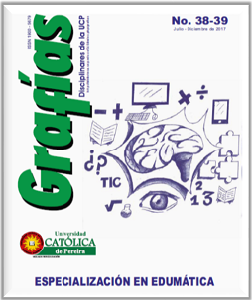Adaptations of an inter-learning curricular guide through the pedagogical use of TIC
DOI:
https://doi.org/10.31908/grafias.v0i38-39.1372Keywords:
Pedagogical use of ICT, new school, significant learningAbstract
This article is a job study, which show the pedagogy impact about the use of Information and Communication Technology (ICT), in the rural middle with methodology new school, going to take account the posture of generate the students motivation and their autonomy, fundamental and important factors to achieve during the teaching and learning processes. In the development of this work, applies a comparative through the application of the use of learning strategies and the adequate appropriation of the ICT. In the same way, it was applying the methodology new school as usual, in order to assess the impact about the use and implementation of ICT in this methodology. This exploration work shows strengthening of the methodology new school supported by the implementation of ICT during the teaching process, also makes relevant the importance that teaching planning activities have, so during this process the teacher has to apply different ICT during the activities in his class. Also those activities muss have a pedagogical meaning which the aim to potentiate their pedagogical meaning.
References
Ausubel, D. (1983). Teoría del aprendizaje significativo. Fascículos de CEIF, 1, 1-10.
Carrasco, F. (2016). Desarrollo de habilidades mediante el aprendizaje autónomo. 3C Empresa, 5(3), 52-67.
Coll, C. (2001). Psicología de la educación y prácticas educativas mediadas por las tecnologías de la información y la comunicación. Sinéctica, 25, 1-24.
De Gregory, W. (1999). Del poder de los tres cerebros. Bogotá: Editorial Kimpres Ltda.
FAO, (2004). Educación para la población Rural en Brasil, Chile, Colombia, Honduras, México, Paraguay y Perú. PROYECTO FAO-UNESCO-DGCS/ITALIA-CIDEREDUC. Santiago de Chile: Centro de Investigación y Desarrollo de la Educación (CIDE).
Jonassen, D. (1999). El diseño de entornos constructivistas de aprendizaje. Universities and Knowledge Society Journal, 3(2), 8-20.
Mauri, T., Onrubia, J., Coll, C., y Colomina, R. (2016). La calidad de los contenidos educativos reutilizables: diseño, usabilidad y prácticas de uso. Revista de Educación a Distancia. Núm. 50. Artíc. 8. 15-Jul-2016.
Meneses, A. (2012). Características del aprendizaje autónomo de los estudiantes del programa de enfermería de la Universidad de Pamplona. Revista Ciencia y Cuidado, 9(1), 24-33.
Ramirez, G. A. (2012). Aprendamos química en ambientes virtuales. Institución educativa la inmaculada concepción, Guarne, Antioquia.


